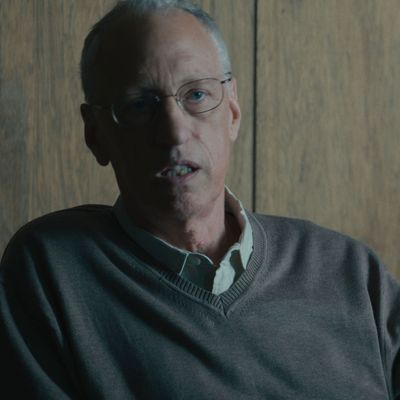
Errol Morris takes a lot of risks with his new Netflix psycho-documentary series Wormwood. He’s mixing real-life interviews with elaborate, star-studded reenactments for the first time in his career; he’s ditched his trademark Interrotron camera setup, instead shooting his subjects from a dizzying array of angles while they sit stationary; he’s quoting Hamlet and the Bible, which surely violates some high school English term paper bylaws; and in this first episode, he throws down the gauntlet by accusing the CIA of torture, murder, and conspiracy. But the biggest risk Morris takes just might be the most familiar image he’s got for us: an opening-credits sequence set to a mid-century businessman plummeting to his death from a New York high-rise. Ring any bells?
It’s not like Morris to ape someone else’s imagery, let alone a sequence as iconic and pitch-perfect as the Mad Men opening titles. So why do so now? With its central mystery involving hallucinogenic experiments within the U.S. government, Wormwood is the most ambitious project the director has yet tackled, even taking into account the time he exonerated a death-row inmate in The Thin Blue Line or his “enhanced interrogation” sessions of Robert McNamara and Donald Rumsfeld. It also seems perfectly tailored to capitalize on the true-crime boom that other Netflix documentaries and their siblings in the podcast world have helped usher in, so maybe opening on something familiar is Morris’s way of reassuring the audience that we can handle what he’s about to throw at us.
Anyway, that dying man was real, even if his brain may have been compromised at the time. His name was Dr. Frank Olson, and he was an Army scientist whose CIA colleagues worked on Project MKUltra, and who was unknowingly dosed with LSD in 1953. You’ve likely heard of MKUltra before: It’s the one where U.S. intelligence was studying the effects of LSD and other hallucinogenic drugs on humans, searching for a good deal of unsavory things like a truth serum, new ways to effectively torture and disorient enemies, and cocktails to breed super-soldiers who could themselves withstand torture. In the popular imagination, it represents not only our country’s two-faced approach to drugs, but also the purest form of sci-fi CIA hijinks typically conjured by our fictions.
Morris is far from the first storyteller to dive into these murky waters. Jon Ronson previously spent time with the Olson family for his book The Men Who Stare at Goats, as have many reporters over the years. In Netflix’s own canon, Eleven from Stranger Things is an MKUltra baby. But judging by “No Other Love,” Morris’s interest in the topic isn’t so much in the headline-grabbing druggie mutant stuff as the more sinister internal ethics of the CIA and the devastation they wrought on Olson’s family. Days after Olson’s special ops boss Vincent Ruwet slipped him the LSD mickey during a retreat at Deep Creek Lake, Maryland, the subject plummeted to his death from a hotel window, a death whose cause the CIA could neither confirm nor deny to his survivors. “He fell or jumped out the window,” they announced, in a bit of linguistic jujitsu. Two decades later, after parts of MKUltra became declassified by the Rockefeller Commission and New York Times journalist Seymour Hersh went digging in a post-Watergate fit of investigative fervor, he told the family point-blank, “How you could live with this bullshit story for 22 years is beyond me.”
Setting the stage for Morris’s own bullshit digging, the first episode of Wormwood collapses the time period between 1953; a public apology from President Gerald Ford in 1975 designed to stave off a lawsuit from the family; and the present day, where Morris gathers Olson’s son Eric and attorney David Kairys to discuss the madness to follow. In between, Morris offers up his own interpretation of the events, casting a meek Peter Sarsgaard as Olson and a snarling Tim Blake Nelson as Dr. Sidney Gottlieb. There’s something lacking in this dramatic rendition so far, though, and it seems obvious Morris isn’t used to directing big-time actors. (The sequence where Gottlieb drugs Olson is staged clumsily and is so over-the-top in its villainy that it feels like it belongs on the History Channel in the middle of the afternoon.) One hope as the miniseries progresses is that Morris commits to fleshing out the staged sequences, or at least reframing them as new evidence comes to light, allowing Sarsgaard, Nelson, and the others to dig into their characters, instead of just throwing them in to break up the present-day interviews and news clippings.
Still, the sheer loopy potential of this story is enough to keep interest high for the next five installments, and with Morris’s obsessive eye for detail and nose for bullshit, he’s the ideal director for seeing past the myth and haze of MKUltra, the CIA, and beyond. Time for another hit of Wormwood. The investigation will only go more surreal from here.
Burning Questions
• What new evidence, if any, has Morris uncovered into the well-trodden story of Frank Olson? And will Wormwood deliver anything close to a satisfying payoff?
• Did Gottlieb drug Olson because the CIA legitimately wanted to monitor his reactions, or as retaliation for something else on his part?

